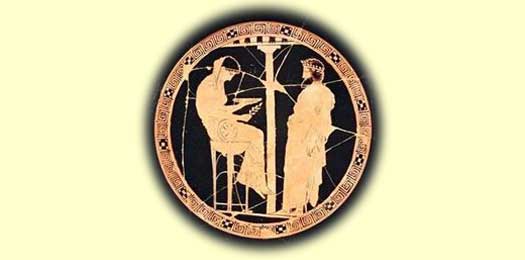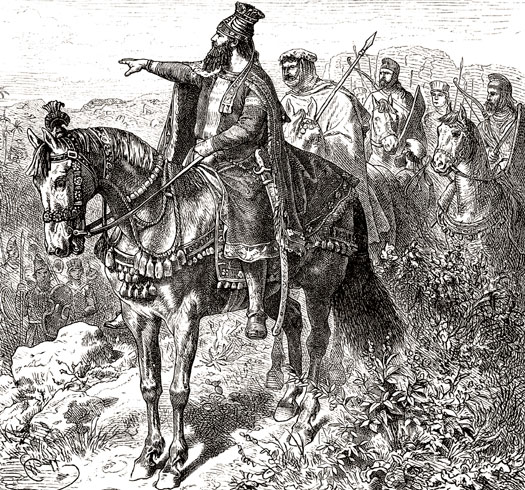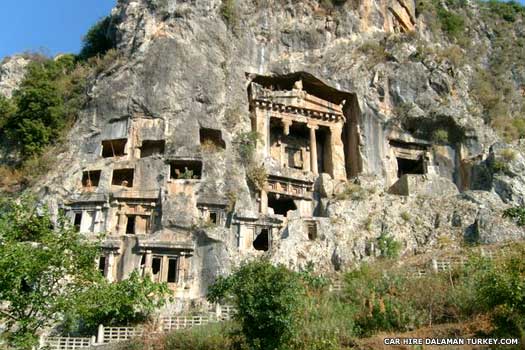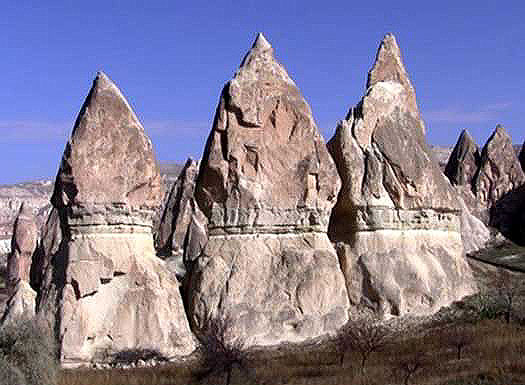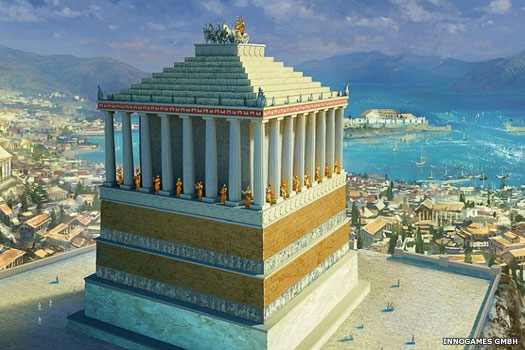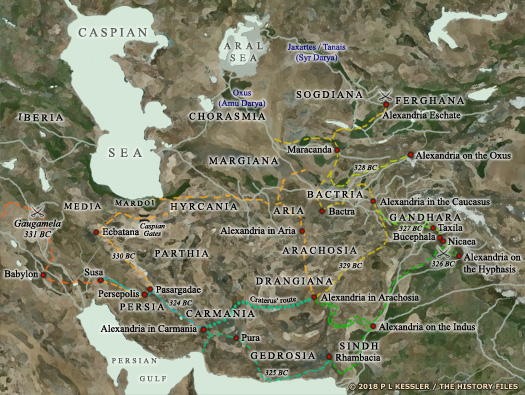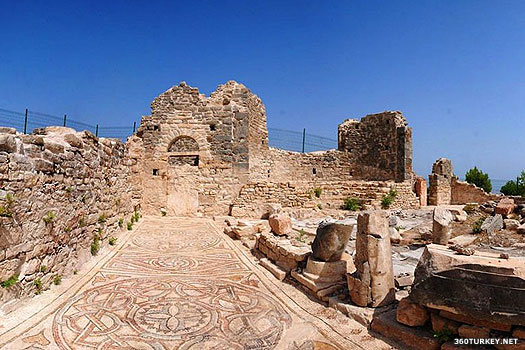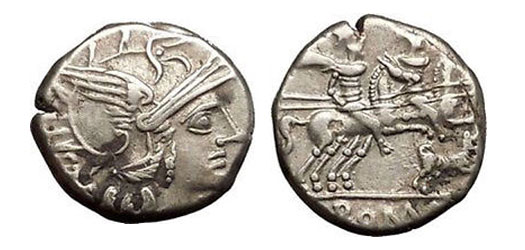
| LUKKA AND LYCIA Inhabited since prehistory, by the fifteenth century BC the southern coast of western Anatolia was home to the Lukka (or Luqqa). With Arzawa to the north and Tarhuntassa to the east, they apparently formed a minor state (or vassal region) of Arzawa, but may have been little more than a confederation of tribes or minor states. The region had no political power - no treaties with the Hittites are recorded - and no Lukka king is ever named. However, they may have been expert seafarers who made yearly attacks along the coast of Alashiya, as well as frequently being involved in land-based attacks inside Anatolia. The nearest relative to their language and that of their later Lycian descendants was Indo-European Luwian, which was generally spoken throughout Anatolia, but they left very few inscriptions. Most of the region's settlements were along the coastline, away from the extremely rugged interior (although some scholars doubt this location for them and refuse even to link Lukka with later Lycia).
According to Herodotus, later Classical Lycia was so-named because of Lycus, the son of Pandion II of Athens after the kingdom was founded by Sarpedon of Crete, implying a Cretan connection to the settlement of western Anatolia. The Greeks give the earliest Lycians (or Lukka) Greek names which of course they did not possess at this time, but perhaps these people existed anyway, to be later altered by oral tradition and changing languages. Either way, the Greek information on Lukka-period kings should be used with caution.
c.2600 BC :
Sarpedon : Brother of Minos of Crete in Greek mythology.
According to Greek mythology, Sarpedon conquers the region after leaving Cilicia. The name of Lycia comes from his successor.
The brother of Lycus, King Aegeus of Athens consults the Oracle at Delphi for advice Lycus : King, and son of Pandion II of Athens in Greek mythology.
c.2000/1700 BC :
Kukunnis : Son of Lukka.
The name of Kukunnis (also the name of a king of Troy in the late fourteenth century BC) can be found in hieroglyphs on the 'Byblos obelisk' found in that city and dating from either 2000 BC or 1700 BC. It has been identified (by Albright) as an authentic Lukkan name, but just who Kukunnis is remains a mystery, although the Lukka are often to be found operating as mercenaries.
c.1430s BC :
To the north of the Lukka, and regularly defeated by the Arzawan king, a Hittite army is moved into Zippasla to provide a permanent garrison. With the kingdom at last secure against Kupanta-Kurunta of Arzawa, King Madduwattas apparently now decides that he is never again going to suffer such indignities as his many defeats. When Dalawa (Tlawa of the Lukka, classical Tlos) and Hinduwa rebel, Madduwattas suggests to the Hittite army commander, Kisnapili, that he takes Hinduwa while Madduwattas takes Dalawa. But while Kisnapili is on his way to Hinduwa, Madduwattas allies himself to Dalawa and, with its help, he ambushes and kills Kisnapili.
c.1375 BC :
The Kaskans suffer the loss of their grain to locusts so, in search of food, they join up with Hayasa-Azzi, Ishuwa, and the Lukka, as well as other Hittite enemies. The devastation to the grain crops may also have been suffered by others, making it not only easy to get them all to unite but highly necessary, and the Hittites may be taken by surprise by the sheer forcefulness of the attack. Recent Hittite resurgence suffers a knock when their fort of Masat is burned down, but then the capital, Hattusa, is itself attacked and burned. This disaster personally weakens the position of the Hittite king but seemingly does little to set back the Hittites themselves.
c.1370s BC :
The Lukka are mentioned in the Armana letters from Egypt, in which they are accused of attacking the Egyptians in conjunction with the Alashiyans.
Iobates / Amphianax : King of Lycia in Greek mythology.
fl c.1280s BC : Iobates is the host of the exiled Bellerophon, and sends the latter to kill the Chimera in Caria. The successful Bellerophon marries the king's daughter and succeeds his father-in-law.
Bellerophon the Corinthian : Son-in-law. King of Corinth.
fl c.1230s? BC :
Hippolochus
c.1208 BC :
A body of Lukka take part in the Libyan-led attack on Egypt which includes various Sea Peoples. Two hundred casualties are recorded for the Lukka, a very small part of the overall number. Families had accompanied the warriors, showing that this was not just a normal raid, that they had been intent on settling there instead.
c.1200 BC :
The Hittite empire collapses, and the Lukka apparently re-emerge as the Lycians.
Lycia / Lykia :
Lying to the west of Pamphylia, the 'bump' of Lycia juts out into the Mediterranean Sea, almost literally pointing towards the island of Cyprus. A Lycian state emerged here in the twelfth century BC (according to legendary stories) and certainly by the sixth century BC (according to historical sources). The state was bordered by Caria to the west and north-west, and Pisidia to the north-east.
Known as Trm̃mis to the Lycians themselves, the name comes from the region of Trm̃mili or Trimili (the modern village of Dirmil stands in the same region). It may have been the Turmiriya of the Persepolis tablets, the Tarmilaa of Babylon, and the Termilae of the Greeks, while today it is Likya in modern Turkish. Lycia should not be confused with its more powerful northerly neighbour, Lydia, Historically-speaking, Lycia probably emerged during or following the twelfth century dark age as a neo-Hittite state which was (almost certainly) a direct descendant of the Lukka and retained its structure as a tightly-knit confederation of fiercely independent minor states. According to Homer, the state was led in the Trojan War by one Sarpedon, but little is known of any Lycian rulers.
Lycia's main cities were Xanthos, Patara, Myra, Pinara, Tlos, and Olympos (each of these was entitled to three votes in the later Lycian League), plus the city of Phaselis. With deep valleys between forested mountains that rise to three thousand metres, Lycia had the benefit of good harbours and seclusion. The Lycian League is perhaps the earliest democratic union in history. The Lycians always had an instinct for collaboration with a strong regional-cultural identity and Lycia is famous for its tradition of independent city states that joined together under the strong Lycian League that was in many ways a model political organisation.
(Additional information from The Persian Empire, J M Cook (1983), and from External Link: Lycian Turkey - Discover the Beauty of Ancient Lycia.)
? - c.1183 BC :
Sarpedon : Grandson of Bellerophon. King of Lycia in Greek mythology.
c.1193 - 1183 BC :
Lycia is traditionally an ally of Troy during the Trojan War against Mycenae and the collected forces of the Achaean kingdoms (as frequently mentioned by Homer). The Lycian troops are led by Sarpedon and Glaucus, descendants of Glaucus of Corinth, but the former is killed by Patroclus.
c.1183? - ? BC :
Megaryon : King of Lycia in Greek mythology.
Persian Satraps of Lykia (Lycia) :
The attempt in 547 BC by the kingdom of Lydia to invade Anatolian lands which now belonged to the Persian empire saw an appropriate Persian response. Cyrus the Great invaded Lydia and crushed it, and then proceeded to capture the rest of Anatolia too. The kingdom of Phrygia and the minor city states of Caria also fell between 549-546 BC, as did the region of Lycia which had its own state in the twelfth century BC (according to legendary stories) and certainly by the sixth century BC (according to historical sources). Following that, a Persian layer of administration was introduced to replace lost kingships.
Lying to the west of Pamphylia, the 'bump' of Lycia (or Lykia without the classical Greek influence) juts out into the Mediterranean Sea, almost literally pointing towards the island of Cyprus. The state was bordered by Pisidia to the north-east, and by the satrapy of KarkÔ (Caria) to the west and north-west. As a minor satrapy itself, Lykia was attached to Caria in terms of oversight. With that too a minor satrapy (although of a higher status than Lycia), it was overseen by the great satrapy of Sparda. In general terms, the more minor the level of administration, the greater extent was any native governance. Lycia was no exception, with native rulers (or governors) being evident during the Achaemenid period - possibly both rulers and governors as Lycia seems to have been formed of various principalities that may have witnessed a continuation of pre-Persian rule but now under Persian oversight (although this can only be conclusively proven at the end of Achaemenid rule). Native names shown below usually include Greek and native versions in that order, plus Iranian versions in parenthesis.
Lycia's main cities were Xanthos, Patara, Myra, Pinara, Tlos, and Olympos (each of these was entitled to three votes in the long-lasting Lycian League), plus the city of Phaselis. With deep valleys between forested mountains that rise to three thousand metres, Lycia had the benefit of good harbours and seclusion, but like other mountainous regions of Anatolia probably made Persian governance quite hard work.
(Information by Peter Kessler, with additional information from The Persian Empire, J M Cook (1983), from The Histories, Herodotus (Penguin, 1996), from Alexander the Great, Krzysztof Nawotka (Cambridge Scholars Publishing, 2009), from A Political History of the Achaemenid Empire, M A Dandamaev, and from External Links: Encyclopaedia Iranica, and Lives of Eminent Commanders, Cornelius Nepos (1886 Edition), and The Government of Syria under Alexander the Great, A B Bosworth (The Classical Quarterly Vol 24, No 1, May, 1974, pp 46-64, Cambridge University Press on behalf of The Classical Association (available at JSTOR)), and Livius.)
549 - 546 BC : The Persian defeat of the Medes opens the floodgates for Cyrus with a wave of conquests, beginning with Cilicia in 549 BC. Harpagus, a Median of the royal house and the main cause of the defeat of the Medes, commands Cyrus' army in Anatolia, conquering it between 547-546 BC. Taken during this campaign are Caria, Lykia, Lydia, Paphlagonia, Phrygia, and Tabal (Cappadocia), and Harpagus and his descendants reign thereafter in KarkÔ (Caria) and (sometimes) Lykia as satraps of the empire, normally within the satrapy of KarkÔ. Khilakku (Cilicia) would also appear to be under his control.
Cyrus the Great freed the Indo-Iranian Parsua people from Median domination to establish a nation that is recognisable to this day, and an empire that provided the basis for the vast territories that were later ruled by Alexander the Great As mentioned in the introduction, even during the Persian empire period Lykia continues to enjoy some level of autonomy under native dynasts. Its seclusion behind high mountains makes it difficult to administer directly anyway, and it seems to chop and change between independence and alliances with various powers. Kybernis of about 480 BC is certainly known, while others strike their own silver coins. According to Isocrates, no Persian ever gains control of Lykia, although dynastic inscriptions of Xanthos show that several of the regional satraps often vie against each other for mastery of it.
546 - ? BC :
Harpagus / Hypargus : Persian satrap of KarkÔ, Lykia, & Sparda. Median general.
525 - 520? BC :
Kosikas / Kheziga (I) : Native leader and Persian vassal king.
520? - 480 BC :
Kybernis / Kyberniskos / Kubernis : Son. Commanded the Lykians of Xerxes' fleet 480 BC.
c.480 - 468 BC :
Invading Greece in 480 BC, the Persians subdue the Macedonians and the Thracian tribes (except for the Satrai, precursors to the Bessoi). Then the vast army of Xerxes (which includes Lykians under the command of Kybernis - the Cyberniscus, son of Sicas, of Herodotus) makes its way southwards and is swiftly engaged by Athens and Sparta in the Vale of Tempe.
The Persians are subsequently stymied at Thermopylae by a mixed force of Greeks - which includes Athenians, Corinthians, Helots, Mycenaeans, Thebans, and Thespians - led by Sparta under King Leonidas. (These events are depicted somewhat colourfully - but no less impressively for that - in the 2007 film, 300.) The Persian army is held up long enough for the Athenians to prepare their navy for a seaborne engagement with the Persian fleet. Subsequently the Persians are utterly defeated both at sea (presumed to include the death of Kybernis) and on land, and the Lykians quietly withdraw from any alliance with them to go their own way for a generation (until 468 BC).
480 - ? BC :
Kosikas / Kheziga (II) : Son. Nominally independent.
468 - 387 BC :
Athens wrests control of Lykia away from any possible remaining Median 'occupier' kings and Persian control. The number of Greek-speakers in the region is already starting to outnumber that of the native Lykians, with the eventual result that, by the Argead period in the late fourth century and its subsequent Hellenic phase, the native language disappears completely in the face of full Hellenisation.
The rock-cut Lycian tombs, near Dalyan, were created around 400 BC, as part of the still-mighty remnants of the ancient port city of Kaunos, founded in the tenth century BC as a port city ? - 440 BC :
? / Kuprilli : Son. Athenian League member. Name shown on coins.
? BC :
Kosikas / Kheziga (III) : Grandson and regent.
? - 440 BC :
? / Arppakhu (Harpagus / Zopyrus?) : Son-in-law of Kuprilli and regent.
c.450 - 430/20 BC :
? / Teththiweibi : Relationship unknown.
c.440 - 410 BC :
Gergis / Kheriga : Son of Harpagus.
429 BC :
By this time many Lykian cities have stepped back from their membership of the Athenian League following the gradual decline of Athens during the Peloponnesian Wars of 431-404 BC. The city is undergoing a period of transition as the archons fade in importance in favour of the strategoi. Only Phaselis and Telmessos remain. An Athenian expedition in this year to force Lykian re-engagement ends in its military defeat.
c.410 - 390 BC :
? / Kherei : Brother.
c.390 - 380 BC :
? / Erbbina (Arbinas) : Son. Last of his line, centred on Telmessos.
387 BC :
Lykia's membership of the Athenian League of which it has been part since 468 BC is now, in effect, cancelled. The Athenians are usually good at ensuring that member states are unable to secede by establishing the stipulation in the treaty, but on this occasion they seem to have forgotten that particular point. The region once again accepts Persian oversight. One Mithrapata rules seemingly at the same time as Erbbina, although not necessarily in opposition. He does eventually come into competition with Arttum̃para of Telmessos though.
fl 390s - 380s BC :
Mithrapata : Native ruler, of areas of Lykia.
c.380 - ? BC :
? / Arttum̃para (Artembares) : Native ruler of Telmessos. Defeated by Pericles.
? - c.360 BC :
Pericles / Perikles : Native ruler, of Limyra. Removed by Persia.
367 - 358 BC : Ariobarzanus, satrap of Phrygia, joins Datames, satrap of Khilakku and Katpatuka, in revolt against Artaxerxes II. Autophradates, satrap of Sparda is ordered to suppress the rebellion and he manages to expel Ariobarzanes from the greater part of his satrapy. In 365 BC, Athens sends thirty ships and 8,000 mercenaries to aid Ariobarzanus. He rewards Athens with the gift of Sestos and Crithote, cities on the Thracian Chersonesus.
The Persian satraps of Katpatuka found themselves in a land that was filled with Hittite monuments that predated their arrival by at least half a millennium Soon all of Asia Minor (Anatolia) revolts against Artaxerxes II, with Datames also having seized Paphlagonia. At some point here in Lykia, Arttum̃para of Telmessos is defeated by Perikles of Limyra. In 362 BC, even Autophradates is driven to join the rebels. Sparta, and also Takh˘s, pharaoh of Egypt, send substantial help to the rebels. Two years later, in 360 BC, Ariobarzanes is betrayed by his son, Mithridates, and is executed.
The satrapal revolt is finally suppressed in 359-358 BC during which time - around 360 BC - Mausolus, satrap of KarkÔ, has been able to extend the territory under his command by expanding into Lykia - independent again during the bulk of the revolt - to remove its dynastic line of rulers (principally Perikles), and also into eastern Greece in the form of Ionia and several of the islands.
c.360 - 353 BC :
Mausolus : Satrap of KarkÔ. Gained Lykia.
353 - 351 BC :
Artemisia (II) : Widow & sister of Mausolus. Satrap of KarkÔ.
351 - 344 BC :
Idrieus / Hidrieos : Brother. Satrap of KarkÔ.
344 - 340 BC :
Ada : Widow and sister. Satrap of KarkÔ. Expelled.
340 BC :
Ada is expelled from Halicarnassus by her brother, Pixodarus, who seizes the satrapal office of KarkÔ. Ada retreats to the inland fortress of Alinda, which has been equated with the Hellenistic city of Alexandria ad Latmum near Demircideresi in south-western Turkey. She continues to claim the office and title of satrap and Pixodarus seems unable to prevent it.
The great mausoleum of Mausolus (brother of Ada) is reproduced here in CGI, overlooking Halicarnassus, but plans announced in 2019 may see it 'restituted' along with a host of other historical structures 340 - 335 BC :
Pixodarus : Brother. Satrap of KarkÔ. Died childless.
335 - 334 BC :
Orontobates : Held out in KarkÔ against Alexander's forces.
334 - 333 BC :
In 334 BC Alexander of Macedon launches his campaign into the Persian empire by crossing the Dardanelles. The first battle is fought on the River Graneikos (Granicus), eighty kilometres to the east. Dismayed at the Persian defeat, Satrap Arsites of Daskyleion commits suicide. Sparda surrenders, but KarkÔ's new satrap holds out in the fortress of Halicarnassus with the Persian General Memnon. The fortress is blockaded and Alexander moves on to fight the Lykian mountain folk during the winter when they cannot take refuge in those mountains.
The campaigning season of 333 BC sees Darius III and Alexander miss each other on the plain of Cilicia and instead fight the Battle of Issos on the coast. Darius flees when the battle's outcome hangs in the balance, gifting the Greeks Khilakku and Katpatuka, although pockets of Persian resistance remain in parts of Anatolia.
Argead Dynasty in Lycia :
The Argead were the ruling family and founders of Macedonia who reached their greatest extent under Alexander the Great and his two successors before the kingdom broke up into several Hellenic sections. Following Alexander's conquest of the Persian holdings in Anatolia and Syria between 334-331 BC, the Greek empire ruled the region until Alexander's death in 323 BC and the subsequent regency period which ended in 310 BC. Alexander's successors held no real power, being mere figureheads for the generals who really held control of Alexander's empire. Following that latter period and during the course of several wars, Anatolia was divided between Cassander of Macedonia, the Lysimachian empire, and the Antigonid empire.
Persian-controlled KarkÔ (Caria) and neighbouring Lykia (Lycia to the Greeks) had been governed by the Hecatomnid dynasty in the fourth century BC, as hereditary rulers of a sort that was much more possible in the more loosely-controlled Anatolian districts than it would have been elsewhere. Its best-known representative was Mausolus, who seized control of Lycia from its loose collection of native rulers around 360 BC. Local tyranny of this kind was a relatively normal form of government, as it was often elsewhere in the Greek-influenced world. Tyrants were simply strong autocratic leaders rather than anything particularly repressive or unwanted (the latter not including the usual rivalries, of course). Alexander the Great found the sidelined Hecatomnid Queen Ada to be highly welcoming, making his task of securing Caria a very easy one. Lycia was handed to the trusted chief admiral, Nearchus.
(Information by Peter Kessler, with additional information from The Persian Empire, J M Cook (1983), from The Histories, Herodotus (Penguin, 1996), from Anabasis Alexandri, Arrian of Nicomedia, from Panyassis of Halikarnassos: Text and Commentary, PanÝasis, from The Generalship of Alexander the Great, J F C Fuller, from the Historical Dictionary of Ancient Greek Warfare, J Woronoff & I Spence, and from External Links: Encyclopaedia Iranica, and The Geography of Strabo (Loeb Classical Library Edition, 1932).)
334 - 323 BC :
Alexander III the Great : King of Macedonia. Conquered Persia.
323 - 317 BC :
Philip III Arrhidaeus : Feeble-minded half-brother of Alexander the Great.
317 - 310 BC :
Alexander IV of Macedonia : Infant son of Alexander the Great and Roxana.
333 BC :
Nearchus, chief admiral under Alexander and his friend, governs the region as satrap of Lycia and Pamphylia, being responsible for the ports in southern Anatolia. This forces the Persian navy to sail across open waters between Cyprus and the Aegean Sea. The Persian commanders Memnon of Rhodes and Pharnabazus are active in Aegean waters in 333 BC but receive no reinforcements, possibly due to Nearchus' efforts.
The route of Alexander's ongoing campaigns are shown in this map, with them leading him from Europe to Egypt, into Persia, and across the vastness of eastern Iran as far as the Pamir mountain range 333 - 329 BC :
Nearchus / Nearkhos the Admiral : Also held Pamphylia. Recalled in 323 BC. Died c.300 BC.
329 BC :
Nearchus is recalled to Alexander's side. He brings with him reinforcements for the campaign in Persia and is accompanied by Asander, who becomes satrap of Caria in 323 BC. Nearchus' replacement as satrap is Antigonus Monophthalmus. Sources show his assignment there from 331 BC, but perhaps initially he oversees these regions from Greater Phrygia without having a direct hand in administration.
329 - 301 BC :
Antigonus Monophthalmus (One Eye) : Satrap of Greater Phrygia. Also held Pamphylia.
323 - 301 BC :
Upon the death of Alexander, Lycia becomes part of the Antigonid territories. Nearchus remains an ally of Antigonus. At this time a series of tombs are being used in the city of Rhodiapolis (located in the Kumluca district of present day Antalya in Turkey). The cemetery complex is formed of a series of tombs that surrounds a larger necropolis. Often elaborate styles of tomb architecture are used, and the tombs probably grow incrementally, expanding in width and height over multiple generations. When a fresh burial takes place in the tombs, it is placed on top of other graves. Large, two to three-story structures are often the result of such additions. The structures are made of brick and topped with arched roofs.
305 - 301 BC :
During the Fourth War of the Diadochi, in 305 BC the diadochi generals proclaim themselves king of their respective domains following a similar proclamation by Antigonus the year before. In 302 BC, Lysimachus enters western Asia Minor, governed as part of Greater Phrygia, and gains (or regains) control of much of it. Following the death of Antigonus at the Battle of Ipsus in 301 BC, his territories are carved up by the other diadochi.
The earliest of the tombs of Rhodiapolis date to the fourth century BC, during the Argead period of occupation which opened the way for the full Hellenisation of the region and the blossoming of the town under the control of Rhodes 301 - 300 BC :
Pleistarchus : Brother of Cassander of Macedonia. King of Cilicia & Lycia.
301 - c.240 BC :
As part of his Lysimachian empire, Lysimachus gains Ionia, Lydia, Phrygia, and the southern Black Sea coast of Asia Minor. Cilicia and Lycia are initially given to the brother of Cassander of Macedonia, Pleistarchus, but he is forced out in the following year by the Antigonid ruler, Demetrius I Poliorcetes. The region soon also falls under the rule of the Lysimachian empire. Upon the death in battle of Lysimachus in 281 BC, Lycia seems to pass to Egypt, but at some point before about 240 BC it is seized by the Seleucid empire.
c.240 - c.198 BC :
Having declared war on Seleucus II of the Seleucid empire in 246 BC, Ptolemy III of Egypt has enjoyed a great deal of success on campaign as a continuation of the Third Syrian War. Seleucus is distracted by his domineering mother, who forces him to accept his younger brother, Antiochus Hierax, as a co-regent and governor of regions in Anatolia. When Antiochus attempts to create his own independent domain, Seleucus has to sue for peace with Ptolemy in 241 BC. Egypt gains more Seleucid territory along Syria's northern coast (including Seleucia Pieria), and Lycia would also seem to be included in this transfer.
200 - 64 BC : To achieve his part of a treaty with Philip V of Macedonia that is designed to carve up Egypt's colonial possessions, Antiochus III of the Seleucid empire invades Coele Syria. This triggers the Fifth Syrian War and sees Ptolemaic General Scopas defeated at Panion near the source of the River Jordan in 200 BC. This gains Antiochus control of Palestine and Phoenicia (which includes the city of Miletus).
Pictured here are both sides of a Roman silver dinarius from the official mint, dated to around 146 BC - the mounted attacker on the reverse accompanied by his dog is fairly typical as Roman troops would often bring their mastiffs along with them so that, while the soldier was fighting the enemy above with spear and long knife, their dogs would be biting the enemy's legs from below The campaign ends in a peace deal in 195 BC which gains for Antiochus permanent possession of southern Syria (which includes Idumaea, while Ammon takes advantage of the shift in power to declare its own independence), and also of Egyptian territories in Anatolia (which include Lycia). Lycia remains a renewed Seleucid possession for only five years.
Lycia is officially awarded to Rhodes in the Peace of Apamea in 188 BC, following the Roman victory at the Battle of Magnesia over the Seleucid ruler, Antiochus III. It remains so attached until 64 BC, when it becomes a Roman province.
Source :
https://www.historyfiles.co.uk/ |
